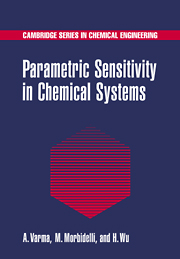Book contents
- Frontmatter
- Contents
- Preface
- 1 Introduction
- 2 Introduction to Sensitivity Analysis
- 3 Thermal Explosion in Batch Reactors
- 4 Runaway in Tubular Reactors
- 5 Parametric Sensitivity in Continuous-Flow Stirred Tank Reactors
- 6 Runaway in Fixed-Bed Catalytic Reactors
- 7 Parametric Sensitivity and Ignition Phenomena in Combustion Systems
- 8 Sensitivity Analysis in Mechanistic Study and Model Reduction
- 9 Sensitivity Analysis in Air Pollution
- 10 Sensitivity Analysis in Metabolic Processes
- Author Index
- Subject Index
2 - Introduction to Sensitivity Analysis
Published online by Cambridge University Press: 04 May 2010
- Frontmatter
- Contents
- Preface
- 1 Introduction
- 2 Introduction to Sensitivity Analysis
- 3 Thermal Explosion in Batch Reactors
- 4 Runaway in Tubular Reactors
- 5 Parametric Sensitivity in Continuous-Flow Stirred Tank Reactors
- 6 Runaway in Fixed-Bed Catalytic Reactors
- 7 Parametric Sensitivity and Ignition Phenomena in Combustion Systems
- 8 Sensitivity Analysis in Mechanistic Study and Model Reduction
- 9 Sensitivity Analysis in Air Pollution
- 10 Sensitivity Analysis in Metabolic Processes
- Author Index
- Subject Index
Summary
Mathematical theories of sensitivity analysis are well developed and described in monographs available in the literature (Tomovic and Vukobratovic, 1972; Frank, 1978). In this chapter we first introduce concepts that are relevant to sensitivity studies of various chemical systems treated in this book, and then illustrate techniques that are most commonly used for evaluating the corresponding sensitivity indices.
In developing the various aspects of sensitivity analysis, we will refer to a variety of chemical systems that exhibit different characteristics. In particular, we are interested in their description in mathematical terms, which is typically provided by a model that gives an explicit or implicit relationship between the system behavior and the input parameters. This behavior is described by the state or output variables, which we indicate in general as dependent variables changing in time and/or in space. The input parameters include the physicochemical parameters of the model (such as those related to reaction kinetics, thermodynamic equilibria, and transport properties) as well as initial conditions, operating conditions, and geometric parameters of the systems. The physicochemical parameters are measured experimentally or estimated theoretically and therefore are always subject to uncertainties. On the other hand, the initial and operating conditions may change in time for a variety of reasons. Both of these obviously affect the system behavior. In particular, by parametric sensitivity we mean the effect of variations of the input parameters on the system behavior. The sensitivity analysis provides effective tools to study the parametric sensitivity of chemical systems.
- Type
- Chapter
- Information
- Parametric Sensitivity in Chemical Systems , pp. 9 - 35Publisher: Cambridge University PressPrint publication year: 1999



